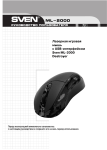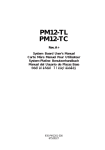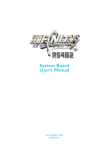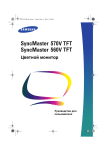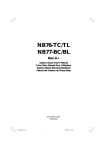Download DFI 855GME-MGF Motherboard
Transcript
855GME-MGF System Board User’s Manual Carte Mère Manuel Pour Utilisateur System-Platine Benutzerhandbuch Manual del Usuario de Placas Base Ðóêîâîäñòâî Ïîëüçîâàòåëÿ 935-855GM1-100 84020501 Quick Setup Guide 1 Quick Setup Guide Copyright This publication contains information that is protected by copyright. No part of it may be reproduced in any form or by any means or used to make any transformation/adaptation without the prior written permission from the copyright holders. This publication is provided for informational purposes only. The manufacturer makes no representations or warranties with respect to the contents or use of this manual and specifically disclaims any express or implied warranties of merchantability or fitness for any particular purpose. The user will assume the entire risk of the use or the results of the use of this document. Further, the manufacturer reserves the right to revise this publication and make changes to its contents at any time, without obligation to notify any person or entity of such revisions or changes. © 2004. All Rights Reserved. Trademarks Product names or trademarks appearing in this manual are for identification purpose only and are the properties of the respective owners. Caution To avoid damage to the system, use the correct AC input voltage range.. To reduce the risk of electric shock, unplug the power cord before removing the system chassis cover for installation or servicing. After installation or servicing, cover the system chassis before plugging the power cord. Battery: 1. Danger of explosion if battery incorrectly replaced. 2. Replace only with the same or equivalent type recommend by the manufacturer. 3. Dispose of used batteries according to the battery manufacturer’s instructions. Notice The system board and accessories in the package may not come similar to the information stated in this manual. This may differ in accordance to the sales region or models in which it was sold. For more information about the standard package in your region, please contact your dealer or sales representative. FCC and DOC Statement on Class B This equipment has been tested and found to comply with the limits for a Class B digital device, pursuant to Part 15 of the FCC rules. These limits are designed to provide reasonable protection against harmful interference when the equipment is operated in a residential installation. This equipment generates, uses and can radiate radio frequency energy and, if not installed and used in accordance with the instruction manual, may cause harmful interference to radio communications. However, there is no guarantee that interference will not occur in a particular installation. If this equipment does cause harmful interference to radio or television reception, which can be determined by turning the equipment off and on, the user is encouraged to try to correct the interference by one or more of the following measures: • Reorient or relocate the receiving antenna. • Increase the separation between the equipment and the receiver. • Connect the equipment into an outlet on a circuit different from that to which the receiver is connected. • Consult the dealer or an experienced radio TV technician for help. Notice: 1. The changes or modifications not expressly approved by the par ty responsible for compliance could void the user's authority to operate the equipment. 2. Shielded interface cables must be used in order to comply with the emission limits. 2 Table of Contents Chapter 1 Quick Setup Guide............................................. 4 1 Quick Setup Guide Quick Setup Guide Chapter 2 English...................................................................... 16 Chapter 3 Français.................................................................... 22 Chapter 4 Deutsch............................................................................... 27 Chapter 5 Español............................................................................ 32 Chapter 6 Ðóññêèé....................................................................... 37 The user’s manual in the provided CD contains detailed information about the system board. If, in some cases, some information doesn’t match those shown in this manual, this manual should always be regarded as the most updated version. Le manuel d’utilisateur dans le CD muni contient renseignement détaillé au sujet de carte de système. Si, en quelque cas, quelque renseignement n’appareille de ce que dit dans ce manuel, ce manuel doit toujours être considéré comme la plus nouvelle version. Das Benutzerhandbuch in der angebotenen CD enthält detaillierte Informationen über die Hauptplatine. Wenn in manchen Fällen manche Informationen nicht denjenigen Informationen dargestellt in diesem Handbuch entsprechen, soll dieses Handbuch als die meist aktualisierte Ausgabe gelten. El uso explicativo contene información detalle sobre la sistema board en el CD preparativo. Si en algún caso, la información no es igual con el uso explicativo, necesita ver el uso explicativo, esque es más nuevo.  ðóêîâîäñòâå ïîëüçîâàòåëÿ íà ïðåäîñòàâëÿåìîì CD äèñêå ñîäåðæèòñÿ ïîäðîáíàÿ èíôîðìàöèÿ î ìàòåðèíñêîé ïëàòå. Èíîãäà íàïå÷àòàííîå ðóêîâîäñòâî ìîæåò íå ñîâïàäàòü ðóêîâîäñòâîì íà CD, òàê êàê ïîñëåäíåå íàèáîëåå ÷àñòî îáíîâëÿåòñÿ è ÿâëÿåòñÿ ñàìûì ñâåæèì. 3 Quick Setup Guide 1 Quick Setup Guide Chapter 1 - Quick Setup Guide 1.1 System Board Layout DDR 1 DDR 2 KB Mouse Winbond W83627HF Socket 479 COM 1 IrDA 1 2nd fan DIMM standby power LED PS/2 power select (JP2) 1 CPU fan 1 ATX power Parallel 1 BIOS 1 FDD VGA 1 IDE 2 IDE 1 1394_2 USB 3-4 Intel 855GME 1394_1 1 LAN USB 1-2 1 1 CPU FSB select (J3) USB power select (JP3) Mic-in Line-in Line-out 1 VIA VT6307 AGP 1 SATA 2 1 SATA 1 1 PCI 1 Slot Realtek RTL8110S PCI-X Slot 1 1 CD-in Audio codec PCI standby power LED PCI 2 Slot Clear CMOS (JP10) Intel 6300ESB 1 Battery 1 1 1 Front audio S/PDIF-out 4 Chassis fan 1 COM 2 Front panel 1 Quick Setup Guide Quick Setup Guide 1.2 Jumpers 1 1.2.1 Clear CMOS Data JP10 X 3 3 2 2 1 1 1-2 On: Normal 2-3 On: (default) Clear CMOS Data 1.2.2 PS/2 Power Select JP2 X 1 2 3 1-2 On: 5V (default) 1 2 3 2-3 On: 5VSB Important: The 5VSB power source of your power supply must support ≥720mA. 5 Quick Setup Guide 1 Quick Setup Guide 1.2.3 USB Power Select JP3 X 3 3 2 2 1 1 1-2 On: 5V (default) 2-3 On: 5VSB Important: If you are using the Wake-On-USB Keyboard/Mouse function for 2 USB ports, the 5VSB power source of your power supply must support ≥1.5A. If you are using the Wake-On-USB Keyboard/Mouse function for 3 or more USB ports, the 5VSB power source of your power supply must support ≥2A. 6 Quick Setup Guide Quick Setup Guide 1.2.4 CPU FSB Select 1 J3 X 3 3 3 2 2 2 1 1 1-2 On: Reserved 2-3 On: 400MHz (Default) 1 All Off: 533MHz Important: • If you are using a CPU whose frequency has been locked by the manufacturer, overclocking will have no effect. • Overclocking may result to the CPU’s or system’s instability and are not guaranteed to provide better system performance. If you are unable to boot your system due to overclocking, make sure to set this jumper back to its default settings. 7 Quick Setup Guide 1 Quick Setup Guide 1.3 Rear Panel I/O Ports PS/2 Mouse Parallel 1394_2 LAN Mic-in Line-in Line-out PS/2 KB COM 1 VGA USB 3-4 USB 1-2 1.4 I/O Connectors 1.4.1 Audio (Rear Audio and Front Audio) Mic-in Line-in W GND AuD_Vcc AuD_R_Return Key AuD_L_Return Line-out Front audio 10 W 9 Mic Mic Power AuD_R_Out N. C. AuD_L_Out 2 1 Rear audio 2-channel 4-channel 6-channel Line-in Rear R/L Rear R/L Lime Line-out Front R/L Front R/L Pink Mic-in Mic-in Center/Subwoofer Light Blue 8 CD TD GND RTS RI RD DTR DSR CTS TPA+ Ground TPB+ +12V (fused) Key TPAGround TPB+12V (fused) Ground 1.4.2 IEEE 1394 COM 2 21 Quick Setup Guide Quick Setup Guide 1394_2 1394_1 21 9 1 W 10 9W 1.4.3 Serial Ports W COM 1 W 9 Quick Setup Guide 1 Quick Setup Guide 1.4.4 CD-in Internal Audio Connector Ground Ground Left audio Right audio channel channel 1 4W 1.4.5 S/PDIF-out Connector SPDIF out Key GND +5V 1 10 4 W Quick Setup Guide Quick Setup Guide 1.4.6 Floppy Disk Drive Connector 33 34 X 2 1 1 1.4.7 Serial ATA Connectors 1 7 1 7 SATA 1 SATA 2 GND TXP TXN GND RXN RXP GND X Note: The Intel 6300ESB south bridge chip allows configuring RAID on Serial ATA drives. It supports RAID 0 and RAID 1. 11 Quick Setup Guide 1 Quick Setup Guide 1.4.8 IDE Disk Drive Connectors 39 40 39 40 X 2 1 IDE 2 2 1 IDE 1 1.4.9 IrDA Connector IRTX Ground IRRX N. C. VCC 5 W 1 Note: The sequence of the pin functions on some IR cable may be reversed from the pin function defined on the system board. Make sure to connect the cable connector to the IR connector according to their pin functions. 12 1.4.10 Cooling Fan Connectors 1 X Power Ground Sense Power Sense X Ground 1 3 2nd fan 3 CPU fan 1 Quick Setup Guide Quick Setup Guide Power Ground Sense 1 3 X Chassis fan 1.4.11 Power Connector 10 20 +12V 5VSB PW-OK X Ground +5V Ground +5V Ground 3.3V 3.3V +5V +5V -5V Ground Ground Ground PS-ON Ground -12V 3.3V 1 11 Important: To ensure that adequate power is provided, use a 250 Watt (or greater) power supply. 13 Quick Setup Guide 1 Quick Setup Guide 1.4.12 DIMM and PCI Standby Power LEDs DIMM Standby Power LED PCI Standby Power LED Important: If the DIMM Standby Power LED or PCI Standby Power LED is lighted, you must power-off the system then turn off the power supply’s switch or unplug the power cord prior to installing any memory modules or add-in cards. 14 Quick Setup Guide Quick Setup Guide 1.4.13 Front Panel Connectors 1 RESET SW HDD-LED 11 12 1 2 PWR-LED X PWR-BTN N. C. 1 N. C. PWR-LED Pin Pin Assignment 2 LED Power 4 LED Power 6 Signal HDD-LED 3 5 HDD Power Signal PWR-BTN 8 PWR-BTN Power 1 0 Signal RESET SW 7 9 Ground RST Signal N. C. 11 N. C. Key 1 2 Key Pin Pin Assignment 15 2 English Chapter 2 - English 2.1 Features and Specifications English Processor • Intel® Pentium® M / Celeron® M processor - 400MHz system bus - Supports 64-bit host data bus and 32-bit addressing • Processor socket: mPGA479M Chipset • Intel® 855GME chipset - Intel® 855GME Graphics Memory Controller Hub (GMCH) - Intel® 6300ESB I/O Controller Hub System Memory • Two 184-pin DDR SDRAM DIMM sockets • 2.5V unbuffered PC1600 (DDR200), PC2100 (DDR266) or PC2700 (DDR333) DDR SDRAM DIMM with ECC/non-ECC support • Supports 128Mbit, 256Mbit and 512Mbit technologies providing maximum capacity of 1GB with x16 devices and up to 2GB with high density 512Mbit technology Note: ECC is supported on both the integrated graphics and AGP card. BIOS • Award BIOS • 4Mbit flash memory Energy Efficient Design • Suppor ts ACPI specification and OS Directed Power Management • Supports ACPI STR (Suspend to RAM) function • Wake-On-Events include: - Wake-On-PS/2 Keyboard/Mouse - Wake-On-USB Keyboard - Wake-On-Ring - Wake-On-LAN 16 English 2 - RTC timer to power-on the system • AC power failure recovery English Hardware Monitor • Monitors CPU/system temperature and overheat alarm • Monitors 5VSB(V)/VBAT(V)/1.5V/3.3V/5V/12V/CPU(V) voltages and failure alarm • Monitors CPU/chassis/2nd fan speed and failure alarm • Read back capability that displays temperature, voltage and fan speed Onboard Graphics Features • Up to 64MB of dynamic video memory allocation • Display core frequency at 133/200/250MHz • Render core frequency at 100/133/166/200/250MHz • Intel® Dual-Frequency Graphics Technology • 2D graphics engine - Optimized 128-bit BLT engine - 32-bit Alpha Blended cursor - 8-bit, 16-bit and 32-bit color • 3D graphics engine - Enhanced Hardware Binning Instruction Set - Bi-Cubic Filtering - Linear Gamma Blending for Video Mixer Rendering (VMR) - Video Mixer Rendering (VMR) - 3D setup and render engine - DirectX and OpenGL pixelization rules - 266-MegaTexel/s peak performance - 16- and 24-bit Z-buffering; 16- and 24-bit W-buffering - Optimal 3D resolution - Double and triple render buffer • Graphics Power Management - Dynamic Frequency Switching - Memory Self-Refresh During C3 - Intel® Display Power Saving Technology Onboard Audio Features • Realtek ALC655 6-channel audio • 16-bit stereo full-duplex codec with independent variable sampling rate • DirectSound 3DTM compatible • S/PDIF-out interface 17 2 English Onboard LAN Features • RTL8110S Gigabit ethernet controller • Supports 10Mbps, 100Mbps and 1Gbps data transmission • IEEE 802.3 (10/100Mbps) and IEEE 802.3ab (1Gbps) compliant English Serial ATA Interface with RAID • Supports two SATA (Serial ATA) interfaces which are compliant with SATA 1.0 specification (1.5Gbps interface) • Supports RAID 0 and RAID 1 IDE Interface • Supports up to UltraDMA 100Mbps hard drives • PIO Mode 4 Enhanced IDE (data transfer rate up to 14MB/sec.) IEEE 1394 Interface • VIA VT6307 • Supports two 100/200/400 Mb/sec ports Accelerated Graphics Port (A.G.P.) • Supports 1.5V AGP 4x data transfers and 2x/4x fast write protocol (3.3V AGP card is not supported) • AGP 2.0 compliant Rear Panel I/O Ports • 1 mini-DIN-6 PS/2 mouse port • 1 mini-DIN-6 PS/2 keyboard port • 1 DB-25 parallel port • 1 DB-9 serial port • 1 DB-15 VGA port • 1 IEEE 1394 port • 1 RJ45 LAN port • 4 USB 2.0/1.1 ports • Mic-in, line-in and line-out I/O Connectors • 1 connector for an external serial port • 1 connector for 1 external IEEE 1394 port • 1 front audio connector for line-out and mic-in jacks • 1 CD-in internal audio connector • 1 S/PDIF-out connector • 1 connector for IrDA interface • 2 Serial ATA connectors 18 English • • • • • 2 2 40-pin IDE connectors 1 floppy connector 1 ATX power supply connector 1 front panel connector 3 fan connectors English Expansion Slots • 1 AGP 4x slot • 1 PCI-X slot • 2 PCI slots Compatibility • PCI 2.2, Intel AGP 2.0, PCI-X 2.2 and AC ’97 compliant PCB • 4 layers, microATX form factor • 24.4cm (9.61") x 23cm (9.06") 2.2 RAID Configuration The following describes the steps on configuring RAID. 1. Set the “On-Chip Serial ATA” field to “Enhanced Mode”. (Integrated Peripherals submenu - OnChip IDE Device” section of the Award BIOS.) 2. Set the “SATA Mode” field to “RAID”. (Integrated Peripherals submenu - OnChip IDE Device” section of the Award BIOS.) 3. Reboot the PC. 4. When the system powers-up, press the <Ctrl> and <I> keys simultaneously to run the Intel RAID BIOS Setting Utility. The utility is used to configure the Serial ATA drives to RAID 0 or RAID 1. 5. Install the Intel 6300ESB RAID driver. If you are in the process of installing Windows ® XP or Windows® 2000 on RAID configured Serial ATA drives, you will need the provided Intel RAID floppy diskette. If you are installing the driver on existing Windows® XP or Windows® 2000, install the “6300ESB RAID Drivers” that is in the provided CD. 19 2 English Installing the RAID Driver While Installing Windows® XP or Windows® 2000 The steps below will instruct you on installing the 6300ESB RAID driver while in the process of installing Windows® XP or Windows® 2000 on a RAID 0 or RAID 1 Volume Serial ATA drives. 1. Start Windows Setup by booting from the installation CD. English 2. Press <F6> when prompted at the beginning of Windows setup. 3. Press <S> to select “Specify Additional Device”. 4. At this point you should be prompted to insert a floppy disk containing the 6300ESB RAID driver. Insert the provided floppy diskette. 5. Select “Intel® 6300ESB SATA RAID Controller” from the list then press <Enter>. 6. The next screen should confirm that you have selected the Intel(r) RAID controller. Press <Enter> again to continue. 7. Finish the Windows installation. Leave the floppy disk in the floppy drive until the system reboots itself. Windows setup will need to copy the files from the floppy disk again after the RAID volume is formatted, then Windows setup starts copying files. 20 English 2 2.3 Package Checklist The system board package contains the following items: The system board A user’s manual One IDE cable One floppy cable Two Serial ATA data cables One Serial ATA power cable One “Main Board Utility” CD One Intel RAID driver diskette One I/O shield One CPU fan and heat sink assembly English ; ; ; ; ; ; ; ; ; ; If any of these items are missing or damaged, please contact your dealer or sales representative for assistance. 21 3 Français Chapter 3 - Français 3.1 Caractéristiques et Spécifications Français Processeur • Les processeurs Intel® Pentium® M / Celeron® M - Interface du bus système 400MHz - Supporte 64-bit hôte donnée bus et adressage de 32 bits • Socket mPGA479M Français Chipset • Intel® 855GME chipset - Intel® 855GME GMCH - Intel® 6300ESB I/O Controleur Entrée/Sorrtie Mémoire Système • 2 socles DIMM DDR 184-pin • 2.5V non-tamponnés les modules PC1600 (DDR200), PC2100 (DDR266) et PC2700 (DDR333), ECC/non-ECC • Supporte 128Mbit, 256Mbit et 512Mbit technologie pourvoir fournir la capacité maximum 1GB avec dispositifs x16 y jusqu’à 2GB avec 512Mbit technologie Remarque: CCE est supporté par la graphique intégrée et par la carte AGP. BIOS • Compatible avec Award BIOS • Mémoire Flash 4Mbit Design à Haut Rendement Énergétique • ACPI STR (Suspend to RAM) fonction • Réveil-Sur-PS/2 Clavier/Souris et Réveil-Sur-USB Clavier • Eveil Sonnerie et Réveil Par Le Réseau • Minuterie RTC pour allumer le système • Récupération après Défaillance d’Alimentation CA System Health Monitor Fonctions • Gère l’alarme de température et de surchauffe de CPU/système • Gère l’alarme de voltage et d’échec de 5VSB(V)/VBAT(V)/1.5V/ 3.3V/5V/12V/CPU(V) 22 Français 3 • Gère la vitesse de ventilateur du ventilateur de CPU/chassis/2nd • Affichage température, voltage et éventez la vitesse Fonctions de la Graphique Intégrée • Jusqu’à 64MB Mémoire Dynamique • Dynamische videospeicherallozierung à 133/200/250MHz • Rendez la fréquence de noyau à 100/133/166/200/250MHz • Intel® Dual-Frequency Graphics technologie • Fonctions 2D moteur de graphiques • Fonctions 3D moteur de graphiques • Fonctions graphiques Power Management Fonctionnalités Onboard LAN • RTL8110S Gigabit LAN • Supporte 10Mbps, 100Mbps et 1Gbps • IEEE 802.3 (10/100Mbps) et IEEE 802.3ab (1Gbps) compatible Français Caractéristiques Audio sur Carte • Realtek ALC655 6-canaux audio • Codec full-duplex 16 bits stéréo avec fréquence d’échantillonnage variable indépendante • DirectSound 3DTM compatible • Interface sor tie S/PDIF Interface Serial ATA avec RAID • Supportant 2 interface SATA (Serial ATA) compatible avec la spécification SATA 1.0 (bande passante à 1.5Gbps) • Supporte RAID 0 et RAID 1 Contrôleur IDE • Supporte des disques durs jusqu’à UltraDMA 100Mbps • IDE Améliorés Mode 4 PIO (vitesse de transfert de données allant jusqu’à 14Mo/sec.) Interface IEEE 1394 • VIA VT6307 • Supporte 2 ports 100/200/400 Mb/séc AGP (Accelerated Graphics Port) • Soutien des cartes supplémentaires 1.5V AGP 4x (1066MB par seconde). Les cartes 3.3V AGP ne sont pas soutenues. • Soutien des spécifications AGP 2.0 23 Français Français Le • • • • • • • • • Panneau des Ports Entrée/Sortie en Arrière 1 port souris PS/2 1 port clavier PS/2 1 port parallèle DB-25 1 port de DB-9 série 1 port de DB-15 VGA 1 port IEEE 1394 1 port RJ45 LAN 4 ports USB 2.0/1.1 Mic-in, line-in et line-out prises audio Français 3 Connecteurs Entrée/Sortie • 1 connecteur pour 1 port série supplémentaires • 1 connecteur pour 1 IEEE 1394 • 1 connecteur audio de l’avant pour la line-out/l’entrée micro • 1 connecteur CD-in audio internes • 1 connecteur S/PDIF-out • 1 connecteur IR • 2 connecteurs Serial ATA • 2 connecteurs IDE • 1 connecteur de FDD • 1 connecteur d’alimentation ATX • 1 connecteur devant panneau • 3 connecteurs de ventilateurs Logements d’Extension • 1 slot AGP 4x • 1 slot PCI-X • 2 slots PCI Compatibilité • Compatible PCI 2.2, Intel AGP 2.0, PCI-X 2.2 et AC ’97 PCB • microATX • 24.4cm (9.61") x 23cm (9.06") 24 Français 3 3.2 Configuration du RAID Les instructions suivantes décrivent les étapes essentielles de la configuration du RAID. 1. Activez le champ “On-Chip Serial ATA” en sélectionnant “Enhanced Mode”. (Sous-menu “Integrated Peripherals” dans la section “OnChip IDE Device” du Award BIOS.) 2. Activez le champ “SATA Mode” en sélectionnant “RAID”. (Sousmenu “Integrated Peripherals” dans la section “OnChip IDE Device” du Award BIOS.) 3. Redémarrer PC. 5. Installez les pilotes Intel 6300ESB RAID. Ci-dessous, vous trouverez les étapes à suivre pour installer le pilote RAID pendant l’installation de Windows® XP ou Windows® 2000 sur un disque Serial ATA configuré pour supporter le RAID. Français 4. Effectuez l’utilitaire Intel RAID BIOS en appuyant sur <Ctrl> et <I> après le démarrage. Cet utilitaire sert à configurer et gérer le RAID sur les disques Serial ATA. Installer le pilote RAID 1. Démarrez le système à sortir du CD d’installation pour effectuer Windows Setup. 2. Appuyez sur <F6> quand vous y serez invité au début de Windows Setup. 3. Appuyez sur <S> pour sélectionner “Specify Additional Device”. 4. Vous serez invité à insérer une disquette contenant le pilote RAID. Insérez la disquette 6300ESB RAID. 5. Sélectionnez “Intel® 6300ESB SATA RAID Controller”. 6. Appuyez sur <Enter>. 7. uivez les instructions sur l’écran pour achever l’installation. 25 3 Français 3.3 Liste de Vérification de l’Emballage L’emballage de la carte système contient les éléments suivants: 1 1 1 1 2 1 1 1 1 1 carte système manuel utilisateur câble IDE câble FDD câble SATA câble d’alimentation SATA CD “Mainboard Utility” disquette Intel RAID plaque I/O ensemble de ventilateur et de radiateur Français ; ; ; ; ; ; ; ; ; ; Français Si l’un de ces éléments n’était pas dans l’emballage ou s’il était endommagé, veuillez contacter votre revendeur ou votre représentant. 26 Deutsch 4 Chapter 4 - Deutsch 4.1 Leistungsmerkmale und Technische Daten Prozessor • Intel® Pentium® M / Celeron® M Prozessor - Interface des Systemreifens 400MHz - Supports 64-bit Wirt Datenübertragungsweg und 32-bit Wenden • Prozessor socket: mPGA479M Chipset • Intel® 855GME chipset - Intel® 855GME GMCH - Intel® 6300ESB I/O Steuerungsplattenmitte Systemspeicher • 2 Sockel 184-pin DDR DIMM • 2.5V ungepuffert PC1600 (DDR200), PC2100 (DDR266) und PC2700 (DDR333), ECC/non-ECC • Unterstützung 128Mbit, 256Mbit and 512Mbit Technologie stellen Sie die maximale Kapazität zur Verfügung 1GB mit Vorrichtungen x16 und bis zu 2GB mit hohe Dichte 512Mbit Technologie Deutsch Beachten Sie: ECC wird durch die integrierte Graphik und die AGP-Karte unterstützt. BIOS • Kompatibilität mit Award BIOS • Flash-Speicher (4Mbit) Energomisches Design • ACPI STR (Suspend to RAM) funktion • Wecken bei Betätigung der PS/2 Tastatur/Maus • Wecken bei USB-Tastatur • Wecken bei Klingeln • Wecken des Systems durch das Netzwerk • RTC-Taktgeber zum Einschalten des Systems • Wiederherstellung der Wechselstromversorgung nach einem Ausfall 27 4 Deutsch Français System Health Monitor Funktions • Überwachung der Temperatur des CPU/Systems sowie Warnsignal bei Überhitzung • Überwachung der Spannungen des 5VSB(V)/VBAT(V)/1.5V/3.3V/ 5V/12V/CPU(V) • Überwachung der Geschwindigkeit des CPU/Chassis/2nd Ventilators • Anzeige Temperatur, Spannung und lockern Sie Geschwindigkeit auf Bordgraphikmerkmäle • Bis zu 64MB dynamische videospeicherallozierung • Anzeige Kernfrequenz an 133/200/250MHz • Übertragen Sie Kernfrequenz an 100/133/166/200/250MHz • Intel® Dual-Frequency Graphics Technologie • 2D Graphikmaschine Funktion • 3D Graphikmaschine Funktion • Graphiken Power Management Deutsch Audiomerkmale auf Platine • Realtek ALC655 6-Kanal-Audioausgang • 16-bit Stereo mit unabhängiger und variabler Abtastfrequenz • Kompatibilität DirectSound 3DTM • S/PDIF-Aus-Schnittstelle Merkmale des LAN auf Platine • RTL8110S Gigabit LAN • Unterstützung 10Mbps, 100Mbps und 1Gbps • IEEE 802.3 (10/100Mbps) und IEEE 802.3ab (1Gbps) Kompatibilität Serial ATA Schnittstelle mit RAID • Unterstützt 2 SATA (Serielle ATA)-Schnittstelle, die mit SATA 1.0 Spezifikation (1.5Gigabits Schnittstelle) konform ist. • Unterstützt RAID 0 und RAID 1 IDE-Controller • Unterstützung der Festplatten bis zum UltraDMA 100Mbps • Erweitertes IDE des PIO-Modus 4 (Datenübertragungsgeschwindigkeit von bis zu 14MB/Sek.) 28 Deutsch 4 IEEE 1394 Schnittstelle • VIA VT6307 • Uunterstützt 2 Ports 100/200/400 Mbps AGP (Accelerated Graphics Port) • Unterstützt 1.5V AGP 4x (1066MB/sek.) Erweiterungskarten. 3.3V AGP Karten werden nicht unterstützt. • Unterstützt AGP 2.0 Spezifikationen Ein-/Ausgabe-Porte an der Rückwand • 1 Mini-DIN-6-Anschluß für eine PS/2-Maus • 1 Mini-DIN-6-Anschluß für eine PS/2-Tastatur • 1 DB-25-Parallelanschluß • 1 serieller DB-9-Anschlüsse • 1 VGA DB-15-Anschlüsse • 1 IEEE 1394-Anschlüsse • 1 RJ45 LAN-Anschlüsse • 4 USB 2.0/1.1-Anschlüsse • Mic-in, line-in und line-out Audio-Anschlußbuchsen Deutsch Ein-/Ausgabe-Steckverbinder • 1 Anschlußfassung für 1 zusätzliche externe serieller Anschlüsse • 1 Anschluß für eine externe IEEE 1394 Schnittstelle • 1 Frontaudioanschluß für die externe line-out und mic-in • 1 interne Audioanschlüsse (CD-in) • 1 S/PDIF-out Anschluß • 1 IR-Anschluß • 2 Serial-ATA-Anschlüsse • 2 IDE-Anschlüsse • 1 Floppy-Anschlüsse • 1 Anschlußstecker für das ATX-Netzgerät • 1 Frontabdeckung Stecker • 3-ventilator-Anschlüsse Erweiterungssteckfasssungen • 1 AGP 4x-Einbauplätzen • 1 PCI-X-Einbauplätzen • 2 PCI-Einbauplätzen Kompatibilität • Kompatibilität mit PCI 2.2, Intel AGP 2.0, PCI-X 2.2 und AC ’97 29 4 Deutsch Die Druckplatte • microATX • 24.4cm (9.61") x 23cm (9.06") 4.2 RAID-Konfiguration Français Das folgende beschreibt die Schritte auf zusammenbauenüberfall. 1. Stellen Sie das Feld “On-Chip Serial ATA” auf “Enhanced Mode”. (Submenu Integrated Peripherals - “OnChip IDE Device” Teil Award BIOS.) 2. Stellen Sie das Feld “SATA Mode” auf “RAID”. (Submenu Integrated Peripherals - “OnChip IDE Device” Teil Award BIOS.) 3. Laden Sie den PC neu. 4. Drücken Sie nach dem Star ten Ihres Computers die Taste <Ctrl> und <I>, um Intel RAID BIOS Utility aufzurufen, die zur Einstellung und Verwaltung von RAID-Disks der Serial ATAInterfaces notwendig ist. 5. Stellen Sie die Drivers Intel 6300ESB RAID. Die Einstellung des RAID Driver während der Installation von Windows® XP oder Windows® 2000. Deutsch Die Einstellung des RAID Driver 1. Starten Sie die Windows-Einstellung vom Einstell-CD. 2. Drücken Sie die Taste <F6>, um die Windows-Installation zu beginnen. 3. Drücken Sie <S> , um “Specify Additional Device” zu wählen. 4. Sie bekommen den Hinweis, die Diskette mit dem RAID Driver einzulegen. Legen Sie die Diskette 6300ESB RAID ein. 5. Wählen Sie “Intel® 6300ESB SATA RAID Controller”. 6. Drücken Sie <Enter>. 7. Folgen Sie den weiteren Hinweisen. 30 Deutsch 4 4.3 Verpackungsliste In der Verpackung der Systemplatine sind folgende Artikel enthalten: ; ; ; ; ; ; ; ; ; ; 1 Systemplatine 1 Benutzerhandbuch 1 IDE-Kabel 1 FDD-Kabel 2 SATA-Kabel 1 SATA-Energiekabel-Kabel 1 CD mit “Mainboard Utility” 1 Diskette Intel RAID driver 1 I/O-Shutzdeckel 1 Ventilator und Kühlblech Deutsch Fehlt einer dieser Ar tikel oder weist einer dieser Ar tikel Beschädigungen auf, wenden Sie sich an Ihren Händler oder Vertreter. 31 5 Español Chapter 5 - Español 5.1 Características y Especificaciones Procesador • Procesador Intel® Pentium® M / Celeron® M - Interface de la barra sistémica 400MHz - Soporta ómnibus de datos 64-bit de anfitrión y dirección 32-bit • Zócalo: mPGA479M Chipset • Intel® 855GME chipset - Intel® 855GME GMCH - Intel® 6300ESB Hub de Controlador I/O Memoria de Sistema • 2 184-pin DDR DIMM asientos • 2.5V unbuffered PC1600 (DDR200), PC2100 (DDR266) o PC2700 (DDR333) DIMMs, ECC/non-ECC • Soporta 128Mbit, 256Mbit y 512Mbit tecnología proporcione la capacidad máxima 1GB con dispositivos x16 y hasta 2GB con tecnología de alta densidad 512Mbit Nota: ECC se apoya en ambos los gráficos integrados y tarjeta de AGP. Español BIOS • Award BIOS, Memoria Instante (4Mbitios) 32 Diseño Energia Eficiente • ACPI STR (Suspend to RAM) función • PS/2 Teclado/Ratón und USB Teclado de Wake-On • Wake-On-Ring y Wake-On-LAN • Temporizador de RTC para encender el sistema • Recuperación de Fracaso de Energía AC Funciones de Monitor de Salud del Sistema • Monitores de los CPU/sistema temperaturas y alarma acalorada. • Monitores de voltajes de 5VSB(V)/VBAT(V)/1.5V/3.3V/5V/12V/ CPU(V) Español 5 • Vigila la velocidad del abanico del abanido del CPU/chassis/2nd • Demostración temperaturas, voltajes y aviente la velocidad Características de Gráficos Interno • Hasta 64MB of asignación de memoria video dinámica • Frecuencia de la base de la exhibición en 133/200/250MHz • Rinda la frecuencia de la base en 100/133/166/200/250MHz • Intel® Dual-Frequency Graphics tecnología • 2D motor de los gráficos • 3D motor de los gráficos • Gráficos Power Management Características de Audio En Tablero • Realtek ALC655 6-canal audio • 16-bit dúplex completo estéreo de con independiente frecuencia de muestreo variable • DirectSound 3DTM compatible • Interfáz de S/PDIF-out Características de LAN Interno • RTL8110S Gigabit LAN • Soporta 10Mbps, 100Mbps y 1Gbps • IEEE 802.3 (10/100Mbps) y IEEE 802.3ab (1Gbps) compatibilidad Interfaz Serial ATA con RAID • Permite 2 interfaz SATA (Serie ATA) la cual es compatible con la especificación SATA 1.0 (interfaz 1.5Gbps) • Soporta RAID 0 y RAID 1 Controlador de IDE • Soporta las unidades duras hasta de UltraDMA 100Mbps • PIO Modo 4 Realzada IDE (tasa de transferencia de dato hasta 14MB/seg.) Español Interfaz IEEE 1394 • VIA VT6307 • Soporta 2 ports 100/200/400 Má/sec AGP (Accelerated Graphics Port) • Soporta placas 1.5V AGP 4x (1066Mb/seg.). Tarjetas AGP 3.3V no se soportan. • Soporta especificaciones AGP 2.0 33 5 Español Panel de reverso de conectores de entrada - Salida • 1 puerto de ratón PS/2 mini-DIN-6 • 1 puerto de teclado mini-DIN-6 PS/2 • 1 puerto paralelo de DB-25 • 1 puerto de serie DB-9 • 1 puerto de VGA DB-15 • 1 puerto de IEEE 1394 • 1 puerto de RJ45 LAN • 4 puertos de USB 2.0/1.1 • Mic-in, line-in y line-out enchufes de audio I/O Conectores • 1 conector para 1 puerto de serie externo adicional • 1 conector para un puerto de IEEE 1394 • 1 conectador audio delantero para la salida extrema de line-out y el micro • 1 conector de CD-in audio interno • 1 conector S/PDIF-out • 1 conector de IR • 2 conectores de Serial ATA • 2 conectores de IDE • 1 conector de FDD • 1 conector de fuente de alimentación de ATX • 1 conector de conectador del panel delantero • 3 conectores de abanicos Ranuras de Expansión • 1 slot AGP 4x • 1 slot PCI-X • 2 slots PCI Español Compatibilidad • Sumisión de PCI 2.2, Intel AGP 2.0, PCI-X 2.2 y AC ’97 34 La Placa Imprenta • microATX • 24.4cm (9.61") x 23cm (9.06") Español 5 5.2 Configuración RAID A continuación le mostramos los pasos básicos que ha de seguir para llevar a cabo la configuración RAID. 1. Establezca el valor de la opción “On-Chip Serial ATA” como “Enhanced Mode”. (submenú Integrated Peripherals – sección “OnChip IDE Device” de la BIOS Award.) 2. Establezca el valor de la opción “SATA Mode” como “RAID”. (submenú Integrated Peripherals – sección “OnChip IDE Device” de la BIOS Award.) 3. Reanude la PC. 4. Ejecute la utilidad BIOS RAID de Intel pulsando la tecla <Ctrl> y <I> durante el arranque del sistema. Esta utilidad se emplea para configurar y gestionar la función RAID tanto en las unidades Serial ATA. 5. Instale los controladores Intel 6300ESB RAID. Los siguientes pasos le indican cómo instalar el controlador RAID durante el proceso de instalación de Windows® XP o Windows® 2000 en unidades Serial ATA configuradas como RAID. Instalación del Controlador RAID 1. Inicie la instalación de Windows arrancando desde el CD de instalación. 2. Pulse <F6> durante el arranque de la instalación. 3. Pulse <S> para seleccionar otros dispositivos adicionales. Español 4. En este punto, se le solicitará que introduzca un disco flexible conteniendo el controlador RAID. Inserte el disco etiquetado como 6300ESB RAID. 5. Pulse “Intel® 6300ESB SATA RAID Controller” et pulse <Enter>. 6. Pulse <Enter>. 7. Siga las instrucciones que se muestran en pantalla para 35 5 Español completar la instalación. 5.3 Lista de Chequeo del Paquete El paquete del tablero de sistema contiene los siguientes artículos: ; ; ; ; ; ; ; ; ; ; 1 1 1 1 2 1 1 1 1 1 tablero de sistema manual de usuario cable de IDE cable de FDD cable SATA cable de alimentacion SATA CD de “Mainboard Utility” disquette flojo Intel 6300ESB RAID tapa protectora I/O montaje del ventilador y del disipador de calor Español Si cualquieres de estos artículos están perdidos o dañados, favor de ponerse en contacto con su tratante o representantes de venta para la asistencia. 36 Ðóññêèé 6 Ðóññêèé Ãëàâà 6 - Ðóññêèé ÿçûê 6.1 Õàðàêòåðèñòèêè è ñâîéñòâà Ïðîöåññîð • Ïðîöåññîð Intel® Pentium® M / Celeron® M - Èíòåðôåéñ ñèñòåìíîé øèíû 400MHz - Ïîääåðæèâàåò 64-bit “host data bus” è “32-bit addressing” • Socket: mPGA479M ×èïñåò • Intel® 855GME chipset - Intel® 855GME GMCH - Intel® 6300ESB I/O Controller Hub Îïåðàòèâíàÿ Ïàìÿòü • 2 184-pin DDR DIMM ãíåçäà • 2.5V, PC1600 (DDR200), PC2100 (DDR266) è PC2700 (DDR333), ECC/non-ECC • Ïîääåðæèâàåò 128Mbit, 256Mbit è 512Mbit äî 1GB x16 “devices” è äî 2GB 512Mbit Çàìå÷àíèå: ECC ïîääåðæèâàåòñÿ âñòðîåííîé ãðàôèêîé è AGP êàðòîé. BIOS • Award BIOS, 4Mbit Flash Ïàìÿòü Ýíåðãîìè÷íûé Äèçàéí • ACPI STR (Suspend to RAM) • Àêòèâèçàöèÿ Íà Äâèæåíèå Ìûøè • Àêòèâèçàöèÿ Íà Íàæàòèå Êíîïêè USB Êëàâèàòóðû • Àêòèâèçàöèÿ Íà Âõîäÿùèé Çâîíîê • Àêòèâèçàöèÿ Íà Ñåòåâîå Ñîáûòèå • RTC Òàéìåð äëÿ Âêëþ÷åíèÿ Ñèñòåìû • Ñêà÷êè Íàïðÿæåíèÿ Ôóíêöèè Ìîíèòîðèíãà Ñîñòîÿíèÿ Ñèñòåìû • Mîíèòîðèíã òåìïåðàòóðû ïðîöåññîðà/ñèñòåìû 37 Ðóññêèé 6 Ðóññêèé • Mîíèòîðèíã íàïðÿæåíèé 5VSB(V)/VBAT(V)/1.5V/3.3V/ 5V/12V/CPU(V) • Mîíèòîðèíã ñêîðîñòè âðàùåíèÿ âåíòèëÿòîðà CPU/ chassis/2nd Ãðàôèêà • Äî 64ÌÁ äèíàìè÷åñêîé âèäåî ïàìÿòè • ×àñòîòà ÿäðà 133/200/250MÃö • ×àñòîòà ðåíäåðèíãà 100/133/166/200/250Ãö • Intel® Dual-Frequency Graphics Technology • 2D äâèæîê, 3D äâèæîê • Òåõíîëîãèÿ Graphics Power Management Âñòðîåííûé Çâóê • Realtek ALC655 6-channel êàíàëüíûé çâóêîâîé âûõîä • Ïîëíîäóïëåêñíûé 16-bit êîäåê ñ íåçàâèñèìûì èçìåíåíèåì ÷àñòîòû ñæàòèÿ • DirectSound 3DTM compatible • èíòåðôåéñà S/PDIF-out Âñòðîåííûå ñåòåâûå ôóíêöèè • RTL8110S Gigabit LAN • Ïîëíîäóïëåêñíàÿ ïîääåðæêà íà 10 Mbps, 100 Mbps è 1Gbps • Ïîääåðæèâàåò IEEE 802.3 (10/100Mbps) è IEEE 802.3ab (1Gbps) Èíòåðôåéñ Serial A TA è RAID AT • Ïîääåðæèâàåò 2 ïîðòà SATA (Serial ATA), ñîâìåñòèìûé ñî ñïåöèôèêàöèåé SATA 1.0 • RAID 0 è RAID 1 Èíòåðôåéñ IDE • Ïîääåðæèâàåò æåñòêèå äèñêè äî UltraDMA 100Mbps • PIO Mode 4 Ðàñøèðåííûé IDE (ñêîðîñòü ïåðåäà÷è äàííûõ äî 14ÌÁ/ñåê.) Èíòåðôåéñ IEEE 1394 • VIA VT6307 • Ïîääåðæèâàåò 2 ïîðòà 100/200/400 Má/ñåê AGP (Accelerated Graphics Port) • Ïîääåðæèâàåò êàðòû 1.5V AGP 4x (1066Má/ñåê.). AGP êàðòû 3.3V íå ïîääåðæèâàþòñÿ. 38 Ðóññêèé 6 Ðóññêèé • Ïîääåðæèâàåò ñïåöèôèêàöèè AGP 2.0 Ïîðòû Ââîäà/Âûâîäà (I/O) çàäíåé ïàíåëè • 1 ìèíè-DIN-6 PS/2 ïîðò äëÿ ìûøè • 1 ìèíè-DIN-6 PS/2 ïîðò äëÿ êëàâèàòóðû • 1 DB-25 ïàðàëëåëüíûé ïîðò • 1 âíåøíåãî DB-9 ïîðòà è 1 VGA DB-15 ïîðòà • 1 IEEE 1394 ïîðò è 1 RJ45 LAN ïîðò • 4 USB 2.0/1.1 ïîðòà • Mic-in, line-in è line-out ãíåçäà äëÿ çâóêà Ðàçúåìû Ââîäà/Âûâîäà • 1 ðàçúåì äëÿ 1-õ äîïîëíèòåëüíûõ âíåøíèõ serial ïîðòîâ • 1 ðàçúåì äëÿ âíåøíåãî IEEE 1394 ïîðòà • 1 ïåðåäíèé àóäèî ðàçúåì äëÿ âíåøíåãî ëèíåéíîãî âûõîäà è ìèêðîôîíà • 1 âíóòðåííèõ çâóêîâûõ ðàçúåìà (CD-in) • 1 S/PDIF-out ðàçúåì • 1 ðàçúåì äëÿ èíòåðôåéñà IR • 2 Serial ATA ðàçúåìà • 2 IDE ðàçúåìà è 1 ðàçúåì FDD • 1 ðàçúåìà ïèòàíèÿ ATX • 1 Ôðîíò ïàíåëü ðàçúåì • 3 Ðàçúåìû äëÿ âåíòèëÿòîðà Ñëîòû • 1 AGP 4x ñëîòîâ, 1 PCI-X ñëîòîâ è 2 PCI ñëîòîâ Ñîâìåñòèìîñòü • PCI 2.2, Intel AGP 2.0, PCI-X 2.2 è AC ’97 Ïå÷àòíàÿ ïëàòà • microATX , 24.4cm (9.61") x 23cm (9.06") 6.2 Êîíôèãóðàöèÿ RAID Îïèñàíèå íàñòðîéêè RAID. 1. Óñòàíîâèòå ïîëå “On-Chip Serial ATA” íà “Enhanced Mode”. (ïîäìåíþ Integrated Peripherals - “OnChip IDE Device” ðàçäåë Award BIOS.) 39 Ðóññêèé Ðóññêèé 6 2. Óñòàíîâèòå ïîëå “SATA Mode” íà “RAID”. (ïîäìåíþ Integrated Peripherals - “OnChip IDE Device” ðàçäåë Award BIOS.) 3. Ïåðåçàãðóçèòå êîìïüþòåð. 4. Çàïóñòèòå óòèëèòó Intel RAID BIOS, íàæàâ êíîïêó <Ctrl> è <I> ïîñëå âêëþ÷åíèÿ êîìïüþòåðà. Óòèëèòà íóæíà äëÿ íàñòðîéêè è óïðàâëåíèÿ äèñêàìè RAID èíòåðôåéñîâ Serial ATA. 5. Óñòàíîâèòå äðàéâåðû Intel 6300ESB RAID. Äàëåå âû óçíàåòå, êàê óñòàíîâèòü RAID äðàéâåð âî âðåìÿ èíñòàëëÿöèè Windows® XP èëè Windows® 2000. Óñòàíîâêà äðàéâåðà RAID 1. 2. 3. 4. Çàïóñòèòå óñòàíîâêó Windows ñ óñòàíîâî÷íîãî CD. Íàæìèòå <F6> äëÿ íà÷àëà óñòàíîâêè Windows. Íàæìèòå <S> äëÿ âûáîðà “Specify Additional Device”. Âàì ïðåäëîæàò âñòàâèòü äèñêåòó ñ RAID äðàéâåðîì. Âñòàâüòå äèñêåòó Intel 6300ESB RAID. 5. Âûáåðèòå “Intel 6300ESB SATA RAID Controller”. 6. Íàæìèòå <Enter>. 8. Ñëåäóéòå äàëüíåéøèì èíñòðóêöèÿì. 6.3 Êîìïëåêòàöèÿ Êîìïëåêòàöèÿ ïîñòàâêè ìàòåðèíñêîé ïëàòû: ; ; ; ; ; ; ; ; ; ; 40 1 Ñèñòåìíàÿ ïëàòà 1 Ðóêîâîäñòâî ïîëüçîâàòåëÿ 1 IDE øëåéô 1 FDD øëåéô 2 øëåéô Serial ATA 1 øëåéô øíóðîì ïèòàíèÿ Serial ATA 1 CD ñ “Mainboard Utility” 1 äèñêåòà Intel RAID 1 çàùèòíàÿ êðûøêà I/O 1 âåíòèëÿòîðà Åñëè â êîìïëåêòå èç ýòîãî ÷åãî-òî íå õâàòàåò èëè ÷òî-òî èñïîð÷åíî, ïîæàëóéñòà, ñâÿæèòåñü ñî ñâîèì äèëåðîì èëè ïðîäàâöîì.
















































